Early on in my academic study of film history and theory, I realized that the best way to understand the impact that the Movies have on our lives, to investigate these “popular entertainments,” is to watch what is and once was popular. I’ve seen a great number of films that never interested me as a filmgoer (I’m looking at you, Spider-Man 3), but I feel a professional obligation to see them nevertheless. This doesn’t mean that I see everything. (Who has the time, anyway?) For instance, I draw the line at certain kinds of horror movies, like torture porn or possession flicks. Limits. We all have our limits.
But when I examine popular films (by which I mean unequivocal blockbusters or cult classics), whether I am a self-professed fan or not, I tap into another world. Or at least I try. I want to know all the angles: all the controversies, all the gripes, all the pleasures that audiences have and share with one another. I have to see what all the fuss is about.
There was a lot of fuss about the Movies in 2015. Even though comic book superhero movies, studio tentpoles based on YA literature, and reboots of long-dormant franchises still dominated the box office this year, as they almost always do, to paraphrase New York Times film critics Manohla Dargis and A.O. Scott, the major studios pulled off the unthinkable: they gave us stuff that we largely wanted and liked, and thank god their original flicks with mid-size budgets did well, too. Maybe this means that film isn’t dying.
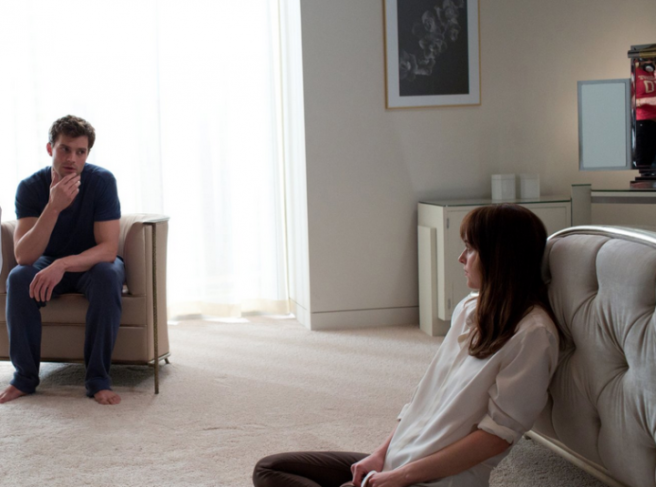
As I actively participated in the hullabaloo surrounding the likes of Fifty Shades of Grey (Sam Taylor-Johnson, 2015), Jurassic World (Colin Trevorrow, 2015), and even Star Wars: The Force Awakens (J.J. Abrams, 2015), the whole world of fandom was thrown into sharp relief. “Fan-made,” which generally connotes those cultural products that are made by amateurs, created in the spirit of or in homage to well known works, suddenly landed on a much bigger stage, with more money attached, in 2015. Now, I’m not suggesting that J.J. Abrams isn’t a professional—even if I do think he’s famous for aping Spielberg and for re-imagining other creators’ properties. He tried his best with Star Trek; he improved upon George Lucas. I also do not mean to diminish Taylor-Johnson’s talents; she elevated her source material (the poorly imagined fan-fiction/erotica drivel written by E.L. James) by focusing on the ridiculousness of what ultimately amounted to no more than the protracted business negotiations of a sexual contract between a man and a woman. Unfortunately, Taylor-Johnson won’t be returning for the next installments, and Universal has allowed James, who objected to Taylor-Johnson’s choices, to pass her husband, Niall Leonard, control over the screenplay for Fifty Shades Darker (James Foley, 2017).
However, while we’re on the topic of credibility, it is worth mentioning again that Trevorrow only had a low-budget romantic comedy to his name (Safety Not Guaranteed, 2012) before Spielberg handed him the keys to the Jurassic Park franchise and World‘s estimated $150 million budget. He foundered a few times while promoting his monstrosity, unable to convince us that the relationship between onscreen leads Chris Pratt and Bryce Dallas Howard didn’t reek of sexism and that the reason women are not called upon to direct giant studio tentpoles is because they simply don’t want to. And to top it all off, Trevorrow delivered a cynical CGI-laden horror show, without any of the thrills, wonder, or charm of the 1993 original. Can you tell that I am a huge Jurassic Park fan?

It is well established that I am not a fan of Star Wars. But I knew that I was going to see the biggest film of the year in the theater. For a while, I just didn’t know when. Originally, I decided that I would wait a couple of weeks, allow the crowds to thin out. Then I decided that, in order to fully immerse myself in the fan culture, I had to see it opening weekend. I had my heart set on seeing filmgoers dressed as their favorite characters, maybe even turned away because they forgot to read the theater’s weapons policy and misguidedly brought that plastic lightsaber from home. I attended a sold-out show on the Sunday morning of its opening weekend. There were no Chewbaccas or Luke Skywalkers in the audience. Hell, we didn’t even have to stand in line before entering the auditorium. There were no hoots or hollers when the film franchise’s logo flashed across the screen. But I had tears in my eyes then, because I knew that I was sharing an experience with a larger, more enthusiastic community of film fans, even if they weren’t sitting in that darkened room with me. (They went at 8 pm Thursday night, right?) All in all, though, it was kind of like seeing any other movie.
Star Wars: The Force Awakens is predicated on the idea that familiarity will sell. That is, it will fill nostalgic hearts and minds and also sell a shit ton of toys. I also understand that most diehard fans of the epic space fantasy series resent mastermind George Lucas’s three prequels, not only for introducing the abomination that is Jar Jar Binks but also for boring audiences to tears. (Full disclosure: I’ve never seen the last two prequels, inelegantly referred to as Episodes II and III.) So it seems only logical that a Star Wars superfan like J.J. Abrams would be able to bring back for his fellow fans what I imagine is the wonder and excitement of the early films. As I like to say, “Star Wars: The Force Awakens is the best movie in the franchise, but that isn’t saying much.” It is a loving pastiche of the original trilogy, only it is well made. Its racially and sexually diverse cast is new and more than welcome, especially since the unequivocal lead is a resourceful young woman named Rey, who, throughout her (mis)adventures with former Storm-Trooper Finn, father figure Han Solo, and furry sidekick Chewbacca, gradually learns the source of all her magical abilities. (It’s the Force, duh.) Star Wars: The Force Awakens may be the ultimate fan movie experience that everyone wanted this year or any year, for that matter (just look at how its box-office haul continues to grow and grow, beating all kinds of records), but it left me with nothing more than a newfound interest in why it is so important and life-defining to so many people.

Instead, I received the superfan experience that I had hoped to witness at Star Wars while attending a special presentation of The Hateful Eight in 70mm. Though I initially balked at the price for a ticket to the film’s limited Roadshow Edition ($20!), I reasoned that the promise of receiving a souvenir program and watching the shadow and light show of actual celluloid—and of a rare, large format, no less—unspooling through a projector had enough value for me. Well, that, and because I wanted to see Quentin Tarantino’s latest. His cinema of indulgence, as I like to think of it, is an acquired taste, but I love how he wears his ecstatic cinephilia on his sleeve. In the case of what is billed as “the eighth film by Quentin Tarantino,” this indulgence extends to amplifying the moviegoing experience for spectators to a new extreme, even for him.
Previously, Tarantino and best friend Robert Rodriguez put on a Grindhouse program in 2007, double billing their unapologetically trashy B-movies Death Proof and Planet Terror, respectively. Just as with Grindhouse, the auteur and his co-conspirators (historically, the Weinstein brothers Bob and Harvey) have injected a film history lesson about bygone exhibition practices back into contemporary pop culture, reminding today’s audiences that going to the Movies used to be a special, spectacular event. The limited Roadshow Edition of The Hateful Eight, complete with an instrumental overture, twelve-minute intermission, a handful of minutes not included on the digital prints of the film, and, not to mention, an earlier release date, subverts current film presentation trends such as surcharging tickets for movies screened in 3D and IMAX formats. You could even make the argument that the real star of the picture was the tangible film itself. Theaters had to be retrofitted with the right technology to screen 70mm, and transporting the heavy reels of film also proved a herculean task (the film is three hours long, mind you). Just read Adam Witmer’s account of what it is like to run the unfamiliar platter system of the 70mm projector at movie theaters in Los Angeles, with Tarantino sitting in the audience, to boot. It is mighty thrilling stuff.

I enjoyed The Hateful Eight as a film story, right up until the end, anyway. But what I will most appreciate about it is the experience that I had going to the Movies on this occasion. Unlike at Star Wars, I had to wait in line to be let into the theater showing The Hateful Eight. Before the presentation began, I watched loving couples, movie nerd guys, and families with teenage or young adult children snap photos of themselves holding up the souvenir program. It was clear that I was a part of something big, something made for fans of Tarantino and for fans of cinema. I was glad that I had plunked down the $20 to attend a film event that hadn’t been replicated in fifty years. Would I do it again? Well, not every film gets or deserves this treatment, so that’s a moot point.
The plethora of reboots, remakes, and re-imaginings of popular films—or, in the case of The Hateful Eight, the reconstruction of 1950s and 60s film exhibition practices—not only allowed fan culture to come to the fore in 2015, it damn near took control of our moviegoing habits. They were everywhere, and more are even coming to the small screens. Netflix will drop all episodes of its original series Fuller House next month, and fans of the family sitcom have already proposed new (sinister) ways of looking at the story of DJ Tanner raising her own kids with the help of friends and family in San Francisco. Twin Peaks is not definitely returning, this time to the cable channel Showtime. These TV shows help prove that “fan-made” doesn’t just mean a low budget, quirky reinterpretation of known properties by pop culture consumers. It also means “for the fans.”
Returning to the realm of the Big Screen, I found myself going to movies this year that I never would have imagined wanting to see if not for the perception that they would be special opportunities for me to participate in fan culture. Star Wars: The Force Awakens was one of them, but so was Mad Max: Fury Road (George Miller, 2015). Now, maybe it was because I had begun to appreciate the action film in all of its tense glory through repeated and ecstatic viewings of Speed (Jan de Bont, 1994)—more on that in part four—that I had wanted to see what one of my favorite film critics, Bilge Ebiri, had dubbed “the Sistine Chapel of action filmmaking.”
If I had ever seen the three original films by George Miller—1979’s Mad Max, 1981’s Mad Max: The Road Warrior, and 1985’s Mad Max Beyond Thunderdome—I didn’t remember them. They mostly resonated with me through their influence on my childhood favorites Tank Girl (Rachel Talalay, 1995) and Demolition Man (Marco Brambilla, 1993). In any case, I loved Fury Road. All at once, it was a recycling bin filled with iconography from every corner of cinema, refashioning elements of the modern vampire myth and Tod Browning’s Freaks (1932) in the process, but it also felt so incredibly fresh. I had never seen a setting like that, simultaneously warm and inviting but also austere and unforgiving. Still, before its release, I never could have predicted that Fury Road, a frenetic road war movie with a preponderance of supposed practical effects and real stuntwork, would go on to top so many critics associations’ lists of the best films from 2015, including that of the National Board of Review. And a nomination for Best Picture? Who would have thunk it, indeed?

I’m not one for sports movies. I rented Southpaw (Antoine Fuqua, 2015) out of boredom and quickly lost interest. However, I rushed at the chance to see Creed (Ryan Coogler, 2015) in the theater, finding it my economic, political, and social obligation to support minority filmmakers. It didn’t matter that the only Rocky movie I had ever seen was the fourth installment in the franchise. On second thought, it probably helped that I had seen Drago bludgeon Apollo Creed to death in the ring in Rocky IV (Sylvester Stallone, 1985). For Creed is about a young black boxer’s coming to terms with his identity as the illegitimate son of the late world heavyweight champion. Aside from the stellar performances—especially by lead Michael B. Jordan—and an amazing single take that approximates what a real-life boxing match is like, I loved the call-backs to the original film, snippets that I recognized because I am a pop culture junkie and know Rocky iconography without ever having seen the movie. I loved the early scene where Adonis “Donnie” Johnson shadowboxes his father, taking Rocky’s place in one of their bouts, footage of which Donnie projects onto a wall, streaming the video from YouTube. Later, his running through the street while neighborhood kids on bikes roll alongside him reminded me of Rocky’s triumphal climb up the steps to the Philadelphia Museum of Art. What an exhilarating cinematic moment; it may have been like what film audiences experienced in 1976. I don’t remember how enthusiastic the crowd was when I saw Creed, but I couldn’t stop grinning from how well co-writer/director Coogler had rebooted, remade, and re-imagined a cultural touchstone that had run out of gas in recent years, how he had made it relevant to today’s audiences. With every day bringing us news of another unarmed African American being gunned down by excessive police force, Creed is a celebration of a strong black body, a multifaceted character with a complex inner life. In other words, it is a reminder that Black Lives Matter and are full of underestimated and untapped potential. Shame the Academy couldn’t see it.
But not everything produced with a strong fanbase in mind succeeded financially or critically. No one really cared to see Terminator: Genysis (Alan Taylor, 2015), probably turned off by its confusing story. Is it a sequel, a prequel, or what? And the remake of Kathryn Bigelow’s 1991 cult classic about a group of bank robbers who spend most days catching some waves off the Los Angeles coast, Point Break, crashed and burned. Like many people who grew up loving the campy original, I was at first hostile to the idea that Warner Bros. was going to distribute a remake of my beloved romance between Johnny Utah and Bodhi. But I learned that it is possible to appreciate both versions. In fact, it is possible to watch them both at the same time.
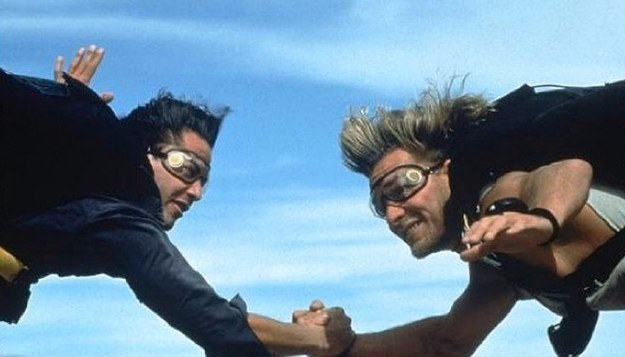
Having seen the trailer a couple of times, I was intrigued by how the filmmakers (including director/cinematographer Ericson Core and screenwriter Kurt Wimmer) had made a case for a new Point Break in 2015. It’s a Point Break set within the world of extreme sports, a picture about the forces of nature and economic inequality. In this version, Johnny Utah is an FBI cadet who, based on his previous experience as a poly-athlete (I’d never heard that term before!) hypothesizes that a series of crimes performed through gravity-defying stunts on separate continents are all the work of the same daring team. They’re chasing what he calls the Osaki Eight, a series of physically demanding stunts that bring one closer to Nature. In other words, this legendary philosophy (the progenitor of it died while attempting his third challenge) is kind of like The Force: it is meant to do good. But the group, led by Bodhi (who else?), commits criminal acts in order to give back, including hijacking millions of dollars being transported by a plane. Releasing the bills miles high to the Mexican villagers below, they also accomplish their goal of strategically falling through the sky and opening their parachutes inside a cave, effectively going from above to below the earth’s surface in one fell swoop. This is not your childhood’s Point Break. In addition to highlighting what was wrong with the original (the surfer gang wasn’t a band of Robin Hoods), the film is a showcase for the striking photography of beautiful natural landscapes and the real stunts performed by professional athletes that are littered throughout.
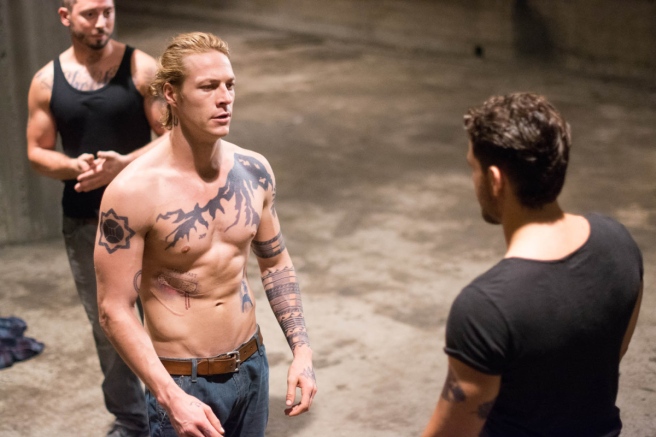
I watched the new Point Break with the original, so ingrained in my memory, playing at the same time in the back of my mind. I could giddily anticipate some gestures and exchanges, such as the moment when Utah fires his gun into the air in a blaze of bullets after just having it trained on Bodhi, thereby allowing his friend/object of desire to get away before the feds arrive. I was the only one in the theater who yelped when she saw James Le Gros cameo as an FBI director (Roach lives!). Despite these call-backs to the original, I can assure you that this Point Break is its own campy thing. It is less a remake and more a re-imagining. And I couldn’t help thinking that an early scene set in a dilapidated Parisian train station (if memory serves) is the closest either film comes to shooting a love scene between the men. Here, Bodhi and his gang hang out, fighting each other for no apparent reason. Although couched as a test of Utah’s character and mettle, the fisticuffs between he and Bodhi signal a love and brutalism that binds them together. I just hope that in twenty-four years, if they even wait that long to remake Point Break, Bodhi and Utah consummate this desire to turn the other into himself. To fuck, as it were.
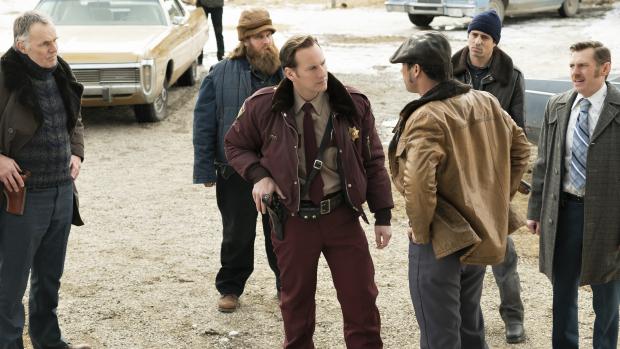
However, the most immersive and rewarding fan experience that I had in 2015—and which carried into 2016—didn’t even involve going to the movie theater. I became obsessed with the FX original series Fargo, created by Noah Hawley and inspired by the 1996 film of the same name written and directed by Joel and Ethan Coen. I initially eschewed the first season of the mock true crime anthology series because Billy Bob Thornton starred. I hold a grudge against the man for having won an Oscar for Best Adapted Screenplay the year that John Hodge’s script for Trainspotting (Danny Boyle, 1996) was nominated in the same category. (More on that film in part four.) However, I had read that the show was amazing, and when I spotted the first season on DVD at my public library, I snatched up the opportunity to see what all the fuss was about Fargo.
Set in 2006, it follows Molly Solverson (Allison Tolman in a stunning debut), a sheriff’s deputy in a small Minnesota town who is the only one who can see what is really going on: perennial schlemiel Lester Nygaard (Martin Freeman, putting on his best north Midwestern accent) is in cahoots with the mysterious assassin Lorne Malvo (a charismatic Thornton). Malvo’s not-quite-solicited murder of Lester’s high school bully sets off a dangerous and absurd chain of events, transforming Lester from a mild-mannered underachiever into a successful insurance salesman with a murderous streak. A suitcase buried in the snow even figures prominently in a second narrative thread concerning Malvo’s manipulation of a grocery store king (Oliver Platt) who hired him to find his blackmailer. That reminds me: I really ought to check out Kumiko, the Treasure Hunter (David Zellner, 2014).
Anyway, I fell under Fargo’s spell immediately. I devoured episodes, reveling in the show’s intricate plotting, nuanced performances, and references not just to the Coens’ film but their whole cinematic universe. I finished in time to watch the second season as it aired, but I waited until my DVR had recorded all ten episodes before diving in. I wanted to go at my own (delayed but faster) pace.
For the second outing, Noah Hawley and his new writer’s room set the story in 1979, during the so-called Sioux Falls Massacre, which Molly’s retired sheriff of a father (Keith Carradine) referenced on a regular basis throughout season one. Going in, I already knew that at least two characters would survive: Molly, now played as a young girl by Raven Stewart, and her father Lou (played as a young state trooper by Patrick Wilson). All bets were off regarding everyone and everything else. The second season is more ambitious in style, story, and setting, incorporating a Midwestern turf war between a German-American crime family in Fargo, the Gerhardts, and a bigger, more streamlined operation in Kansas City that wishes to absorb the former’s drugs distribution business. Peggy Blumquist (Kirsten Dunst), a Minnesota beautician with a dream, accidentally runs over the youngest brother of the Gerhardt clan while he (Kieran Culkin, who knows a thing or two about family dynasties himself) tries to flee the scene of his triple homicide inside a remote diner. Peggy enlists the help of her dim-witted but well-meaning husband, the apprentice butcher Ed (Jesse Plemons), to get rid of Rye Gerhardt’s body. A call-back to the memorable woodchipper scene in the film Fargo ensues, as Ed disposes of Rye’s body the only way he knows how: with a meat grinder.
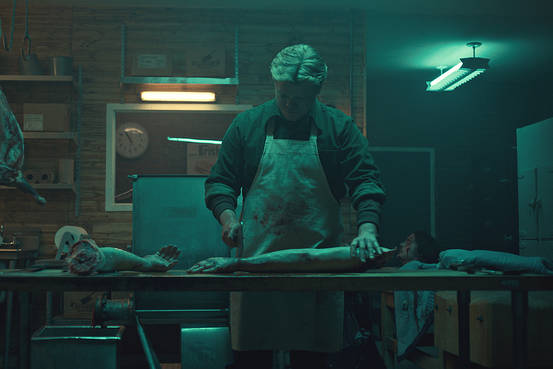
Although the characters and storylines are different between the film and each season of the TV show, a cottage industry exists in which viewers spot references to the film in the new series. Originally, this activity maddened Adam Sternbergh, novelist and contributing editor of New York magazine, whose favorite film is Fargo. Writing for Vulture, he recounts the process of coming to terms with the TV show, whose announcement in 2014 made him feel “something between doubt and existential despair,” by being “able to let go and watch the show in the spirit in which it perhaps was always meant to be watched.” The widening of the show’s scope in season two to include references to the larger Coen “mythology” has influenced Sternbergh to see Fargo as “the ultimate tribute” to the filmmakers, continuing:
The show accepts as a given that the Coens haven’t just created a distinctive visual style, or a stable of recognizable character types, or a set of consistent thematic concerns: They’ve created all those things, with such richness and abundance that their films now qualify as a genre unto themselves. The Coens may have started out making noirs, or Westerns, or comedies, but now they indisputably make Coen Brothers films. Their work has become a stand-alone genre that exists to be referenced, caricatured, borrowed, even shamelessly strip-mined. And it’s rich enough to inspire not just a spinoff, but an expertly executed ongoing televisual homage.
My favorite reference in season two to the Coen Brothers’ filmography comes at the end of the seventh episode. With the eldest Gerhardt brother in his possession, Ed Blumquist phones low-level KC mob enforcer Mike Milligan (a transfixing Bokeem Woodbine) to make a deal: he’ll give him Dodd (Jeffrey Donovan) in exchange for help in getting the Gerhardts off his back. The song “Just Dropped In (To See What Condition My Condition Was In),” made famous by the Dude’s dream sequence in The Big Lebowski (1998), plays out the scene before the end credits roll. But rather than lift Mickey Newbury’s original 1967 track from the film, Hawley and Co. do something extra geeky: they put on an anachronistic funky cover of the song by the pop-synth band White Denim. I’d never heard of this musical group before, but I can only imagine that they probably first heard the song as I did in 1998: while watching The Big Lebowski. In this way, Hawley and his collaborators have taken their Coen fandom to new intertextual heights. Like White Denim, Hawley and his colleagues have taken a text (almost) exclusively associated with the Coen Brothers film genre, to use Sternbergh’s taxonomy, and created something new. Placing the cover of the song inside the playful homage that is Fargo the TV series emphasizes the fan culture from which both the cover song and the TV program were born and which they continue to stimulate.
Read the Montage Series, 2015: A Year in Reflection, from the beginning.













